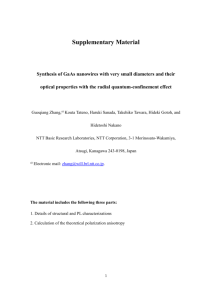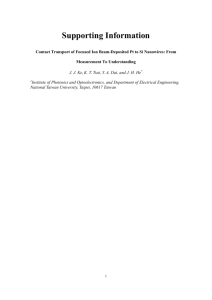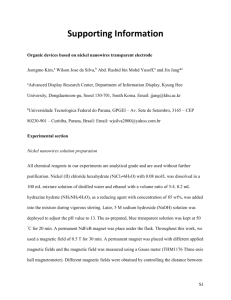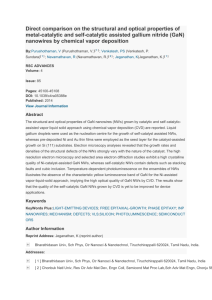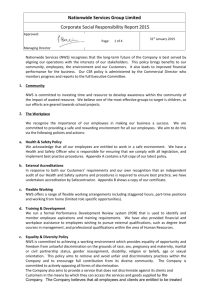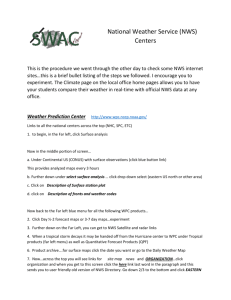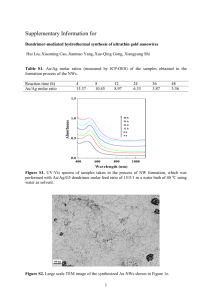Growth and Magnetic characterization of 1D Permalloy nanowires
advertisement
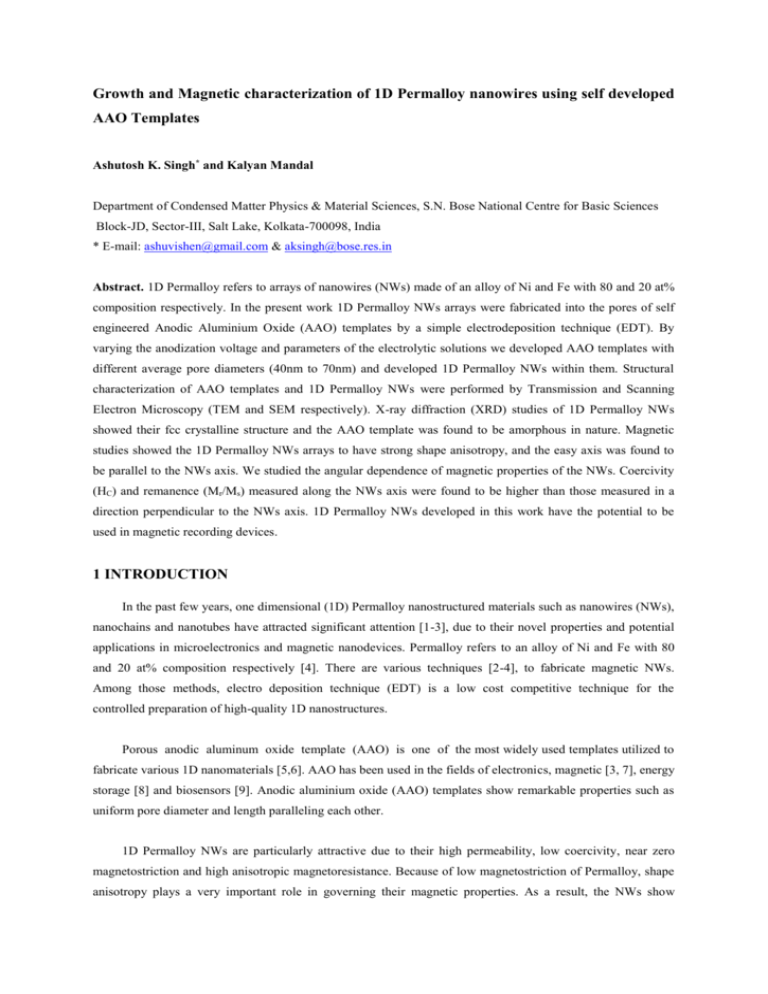
Growth and Magnetic characterization of 1D Permalloy nanowires using self developed AAO Templates Ashutosh K. Singh* and Kalyan Mandal Department of Condensed Matter Physics & Material Sciences, S.N. Bose National Centre for Basic Sciences Block-JD, Sector-III, Salt Lake, Kolkata-700098, India * E-mail: ashuvishen@gmail.com & aksingh@bose.res.in Abstract. 1D Permalloy refers to arrays of nanowires (NWs) made of an alloy of Ni and Fe with 80 and 20 at% composition respectively. In the present work 1D Permalloy NWs arrays were fabricated into the pores of self engineered Anodic Aluminium Oxide (AAO) templates by a simple electrodeposition technique (EDT). By varying the anodization voltage and parameters of the electrolytic solutions we developed AAO templates with different average pore diameters (40nm to 70nm) and developed 1D Permalloy NWs within them. Structural characterization of AAO templates and 1D Permalloy NWs were performed by Transmission and Scanning Electron Microscopy (TEM and SEM respectively). X-ray diffraction (XRD) studies of 1D Permalloy NWs showed their fcc crystalline structure and the AAO template was found to be amorphous in nature. Magnetic studies showed the 1D Permalloy NWs arrays to have strong shape anisotropy, and the easy axis was found to be parallel to the NWs axis. We studied the angular dependence of magnetic properties of the NWs. Coercivity (HC) and remanence (Mr/Ms) measured along the NWs axis were found to be higher than those measured in a direction perpendicular to the NWs axis. 1D Permalloy NWs developed in this work have the potential to be used in magnetic recording devices. 1 INTRODUCTION In the past few years, one dimensional (1D) Permalloy nanostructured materials such as nanowires (NWs), nanochains and nanotubes have attracted significant attention [1-3], due to their novel properties and potential applications in microelectronics and magnetic nanodevices. Permalloy refers to an alloy of Ni and Fe with 80 and 20 at% composition respectively [4]. There are various techniques [2-4], to fabricate magnetic NWs. Among those methods, electro deposition technique (EDT) is a low cost competitive technique for the controlled preparation of high-quality 1D nanostructures. Porous anodic aluminum oxide template (AAO) is one of the most widely used templates utilized to fabricate various 1D nanomaterials [5,6]. AAO has been used in the fields of electronics, magnetic [3, 7], energy storage [8] and biosensors [9]. Anodic aluminium oxide (AAO) templates show remarkable properties such as uniform pore diameter and length paralleling each other. 1D Permalloy NWs are particularly attractive due to their high permeability, low coercivity, near zero magnetostriction and high anisotropic magnetoresistance. Because of low magnetostriction of Permalloy, shape anisotropy plays a very important role in governing their magnetic properties. As a result, the NWs show unidirectional anisotropy along their length. Because of this property, they can be used in many applications such as recording head sensors, magnetic storage devices etc. In this work, we report a simple and low-cost approach to fabricate large area highly ordered nanoporous anodized alumina oxide (AAO) templates by two-step anodization process. 1D Permalloy nanowire arrays were fabricated into the nanometer scaled pores of AAO template using electro deposition technique (EDT). We studied the growth, structural and angular dependence of magnetic properties of NWs. 2 EXPERIMENTAL In order to prepare alumina membrane in a more simple way, we took aluminum sheet with the purity of ~ 99.998% and purchased from Sigma Aldrich with the thickness of ~ 150 nm and area of ~ (5 × 10) mm. One side of the sheets is covered by a Bakelite structure so that only the other side of aluminum comes to the contact of electrolyte solution (oxalic acid C2H2O4). Then a two-step anodizing method was employed to obtain the AAO template. Table 1. Anodizing conditions and morphologic properties of AAO templates. Samples Anodizing Voltage(V) First Anodiza -tion Time (min.) Second Anodization Time (Hr.) Average pore Dia. (nm) AAO1 50 15 3 40 AAO2 55 15 3 58 AAO3 60 15 3 73 AAO4 65 15 3 95 The concentration of oxalic acid was taken as 3 wt% as the voltage was maintained at a constant value of ~ 50 to 65 V to achieve a current density of 200-500 Am-2. The anodization was carried out at 11 0 C to dissipate the heat generated during the exothermic reaction of conversion of aluminum in to alumina. The first anodization was carried out for 15 minutes. The thin porous alumina layer grown on the aluminium foil surface after the first-stage of anodization was removed by chemical etching using a mixture of 60 wt% phosphoric (H3PO4), 28 wt% sulphuric (H2SO4) and 12 wt% nitric (HNO3) acid solution. The etched Al foil was reanodized for 3 hours for the second time keeping all the anodization parameters the same as that in the firststage to obtain more uniform porous structure. Finally the hexagonally arranged nanoporous structure was detached from the base aluminum using mercury chloride (HgCl 2) solution. The as prepared AAO template was dipped inside the 10 wt% phosphoric acid (H3PO4) solution for 15 min for pore widening and pore rounding of the self-organized nanoporous template. Consequently, AAO templates with regular pore arrangement were obtained. Table.1 shows the anodizing conditions for preparing AAO templates. AAO templates with different pore size distribution were obtained by changing the anodizing voltage. To use it as an electrode, one side of it was coated with a conductive gold layer of 0.1 m thickness by the thermal evaporation technique. All electrochemical deposition of NWs was carried out using an AUTOLAB-30 potentiostat and a conventional three-electrode cell (20 cm3 capacity). Electrolyte solution used for the Permalloy NW deposition consists of 100 g/L NiSO4, 20 g/L FeSO4, 20 g/L ascorbic acid and 30 g/L H3BO3. The pH of the solution is maintained at 3.5. Permalloy NWs were electrodeposited at room temperature. The electrodeposition time was 30 minutes. The length of the NWs obtained was ~14m. For structural characterization of NWs, the electrodeposited AAO templates were dissolved in 2M of NaOH solution at room temperature. Figure 1. Top view SEM images of the AAO templates with 40 nm average pore diameter. Scanning electron microscope (FEI Quanta-200 Mark-2) and Transmission electron microscope (FEI TECNAI TF20ST) were used to observe the NWs, their surface morphology and to determine their length and diameter. The crystalline structures of FeNi NWs were investigated by transmission electron microscopy. The phase of the samples was confirmed by x-ray diffraction (X’Pert Pro, Panalytical) and the composition of the NWs was determined using energy dispersive analysis by x-ray (EDAX). Magnetic properties were studied using a vibrating sample magnetometer (Lakeshore, model 7144) while the angle between the NWs and applied field changed from 0 to 90°. 3 RESULTS AND DISCUSSION We grew Permalloy NWs with average diameter of about 40 & 70 nm respectively and the average length of about 14 m. Figure 3(a) shows the SEM image of the Permalloy NWs with 40 nm diameter prepared within AAO templates by electrodeposition technique. This figure also indicates the uniformity in length and diameter of the NWs. To check the composition of the NWs, we performed EDAX measurement shown in Figure 3(b) and found that Fe and Ni was 20:80 in at%. TEM micrograph of NW with diameter 70 nm, shown in Figure 2, indicates its uniform diameter throughout its length. Figure 2. TEM image of the Permalloy nanowire with the diameter of 70 nm. Figure 3. (a) SEM micrographs of NiFe NWs with 40 nm diameter, (b) EDAX spectra with elemental quantification of the sample shows the Ni:Fe = 80:20 in at%. Figure 4. XRD image of Ni80Fe20 NWs. Figure 4 shows the XRD pattern of the 70 nm sample. From the XRD pattern it is observed that the permalloy NWs consists of face centered cubic (fcc) crystal structure. Gold (Au) peaks are also present in the pattern as one side of AAO template was coated with it to make the template conducting. The magnetic hysteresis loops as a function of , the angle between the applied magnetic field and the NWs axis, are shown in Figure 5(a) and 5(b) for 40 and 70 nm NWs respectively. The magnetic properties, such as coercivities (Hc) and remnant magnetization (Mr/Ms) are shown in Figure 6(a) (40nm) and 6(b) (70nm). In case of 40nm NWs, coercivity Hc decreases from 1307 Oe to 258 Oe on changing from 0° to 90°. Similar trend was also observed in the case of 70 nm NWs as well. We also observed that in case of 40nm NWs, remnant magnetization (Mr/Ms) decreases from 0.75 to 0.05 on changing from 0° to 90°. 70 nm NWs also shows similar change in remnant magnetization (Mr/Ms) with . Figure 5. Angular dependence of Hysteresis loops of the Permalloy NWs arrays with diameter (a) 40 nm and (b) 70 nm. Hc for Permalloy NWs of 40 nm are higher than those for the NWs of 70 nm because the larger aspect ratio. In the case of an array of closely spaced nanowires magnetostatic interactions between the nanowires play an important role in governing their magnetic properties as it opposes the shape anisotropy of the individual nanowires [10]. Magnetostatic interaction due to dipolar coupling can be taken into account by including additional anisotropy fields and the net magnetostatic field can be written as [10] HMF = 2πMS − 2πMSγ− 4πMSγ, (1) where the filling factor =3.67(d/D)2, (d/D) being the ratio of the nanowire diameter to the interwire distance. In Eq. (1), besides the self-demagnetizing field 2πMS, two additional contributions come into play. The first one is 2πMS due to charges on the cylindrical wire surfaces producing a dipolar field and the second one is 4πMS developed by the charges at the top and bottom ends. Combining all contributions, Eq. (1) can be written as HMF = 2πMS (1-3) (2) Eq. (2) determines how the Hc and Mr/Ms for NWs depends upon the aspect ratio. We also calculated the magnetic anisotropy field (HK) as a function of for 40nm and 70nm NWs and they are shown in the inset of Figure 6(a) and (b). In case of 40nm NWs, HK increases from 1165 Oe to 4995 Oe on changing from 0° to 90°. Similar change was also observed in 70 nm NWs. Figure 6. Angular dependence of Hc and Mr/Ms of the Permalloy NWs with diameters (a) 40 nm and (b) 70nm. Inset: angular dependence of magnetic anisotropy field (HK) of the respective NWs. The change of the magnetic properties with the direction of applied magnetic field demonstrated that the permalloy NWs prepared in this work showed strong shape anisotropy and the easy axis was parallel to the NWs. As magnetocrystalline as well as magnetostrictive anisotropy were much less in permalloy, shape anisotropy played the most important role in governing their magnetic properties. 4 CONCLUSION The AAO templates prepared by two-step anodizing method have highly ordered and high density pore arrangement, which is proper for the fabrication of 1D nanowire arrays. Permalloy NWs arrays were fabricated into the AAO templates and their morphologic and magnetic properties were characterized. The Permalloy NWs arrays showed strong shape anisotropy with the easy axis parallel to the NWs. 5 ACKNOWLEDGEMENTS This work was supported by BRNS, Government of India under the Project Grant 2009/37/16/BRNS. 6 REFERENCES 1. J. Shen, R. Skomski, M. Klaua, H. Jenniches, S.S. Manoharan, J. Kirschner, Physical Review B, 56, 2340 (2004). 2. W. Wernsdorfer, B. Doudin, D. Mailly, K. Hasselbach, A. Benoit, J. Meier, J.P Ansermet, B. Barbara, Physical Review Letter, 77, 1873 (1996). 3. T. M. Whitney, J. S. Jiang, P. C. Searson, C. L. Chien, Science, 261, 1316 (1993). 4. J. E. Wegrowe, D. Kelly, A. Fromck, S. E. Gitbert, J. P. Ansermet, Physical Review Letter, 82, 3681 (1999). 5. A. Yamaguchi, F. Uejo, T. Yoda, T. Uchida, Nature Materials, 3, 337 (2004). 6. W. Wang, Q. Huang, F. Jia, J. Zhu, Journal of Applied Physics, 96, 615 (2004). 7. K. Nielsch, F. Müller, A. P. Li, U. Gösele, Advanced Materials, 12, 582 (2000). 8. G. L. Che, B. B. Lakshmi, E. R. Fisher, C. R. Martin, Nature, 393, 346 (1998). 9. F. Matsumoto, K. Nishio, H. Masuda, Advanced Materials, 16, 2105 (2004). 10. A. Encinas-Oropesa, M. Demand, L. Piraux, I. Huynen, and U. Ebels, Phys. Rev. B, 63, 104415 (2001).
